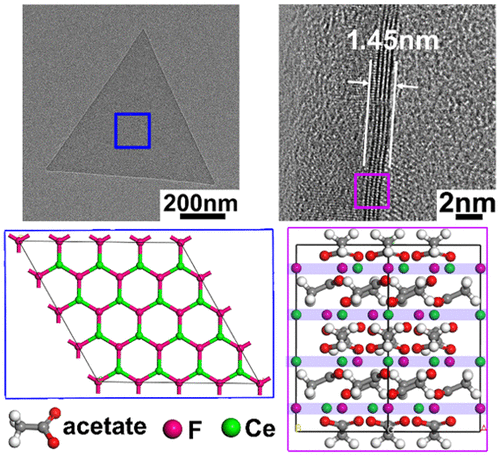当前位置:
X-MOL 学术
›
J. Am. Chem. Soc.
›
论文详情
Our official English website, www.x-mol.net, welcomes your
feedback! (Note: you will need to create a separate account there.)
Two-Dimensional Acetate-Based Light Lanthanide Fluoride Nanomaterials (F-Ln, Ln=La, Ce, Pr and Nd): Morphology, Structure, Growth Mechanism and Stability
Journal of the American Chemical Society ( IF 14.4 ) Pub Date : 2019-07-29 , DOI: 10.1021/jacs.9b05355 Leitao Zhang 1 , Weimin Kang 1 , Qiang Ma 1 , Yingfang Xie 1 , Yunling Jia 2 , Nanping Deng 1 , Yuzhong Zhang 1 , Jing Ju 2 , Bowen Cheng 1
Journal of the American Chemical Society ( IF 14.4 ) Pub Date : 2019-07-29 , DOI: 10.1021/jacs.9b05355 Leitao Zhang 1 , Weimin Kang 1 , Qiang Ma 1 , Yingfang Xie 1 , Yunling Jia 2 , Nanping Deng 1 , Yuzhong Zhang 1 , Jing Ju 2 , Bowen Cheng 1
Affiliation

|
To discover novel two-dimensional (2D) materials is of fundamental importance but remains challenging. In this work, we design a simple and facile bottom-up approach to fabricate a new family of two-dimensional acetate-based light lanthanide fluoride nano-materials (F-Ln, Ln=La, Ce, Pr, Nd) at room temperature and atmosphere pressure, for the first time. Various characterization techniques confirm that as-synthesized F-Ln exhibit an ultrathin morphology with thickness up to 1.45 nm and lateral dimensions up to several hundred nanometers. Microstructure analysis demonstrates that F-Ln are a series of defect-rich 2D nanomaterials, which are consisted of nanocrystals with sub-10 nm domains. Structure characterization of F-Ce, a typical example, infers that BN-like F-Ce one-atom-layers sandwiched by intercalated acetate anions stack alternately along [001] direction to form nanocrystal building blocks of F-Ce. The study of growth mechanism suggests that three procedures are involved in the formation of F-Ce: hydrolysis reaction of cerium (III) acetate, structure transformation induced by fluorine ions and assembly process guided by ace-tate anions. The as-prepared nanosheets show excellent stability with respect to environment stimulis such as air, heat, solvent and high-energy electron beam. This study enriches the library of 2D materials and paves the way for future application of such 2D materials in areas such as catalysis, adsorption, separation and energy storage/conversion.
中文翻译:

二维醋酸基轻镧系元素氟化物纳米材料(F-Ln、Ln=La、Ce、Pr 和 Nd):形态、结构、生长机制和稳定性
发现新型二维 (2D) 材料具有根本重要性,但仍然具有挑战性。在这项工作中,我们设计了一种简单易行的自下而上的方法,在室温下制造了一系列新的二维醋酸基轻镧氟化镧纳米材料(F-Ln,Ln=La,Ce,Pr,Nd)和大气压力,这是第一次。各种表征技术证实,合成的 F-Ln 表现出超薄形态,厚度高达 1.45 nm,横向尺寸高达数百纳米。微观结构分析表明,F-Ln 是一系列缺陷丰富的二维纳米材料,由具有亚 10 nm 畴的纳米晶体组成。F-Ce的结构表征,典型例子,推断类 BN 的 F-Ce 单原子层被插入的乙酸根阴离子夹在中间,沿 [001] 方向交替堆叠,形成 F-Ce 的纳米晶体构建块。生长机理的研究表明,F-Ce 的形成涉及三个过程:醋酸铈 (III) 的水解反应、氟离子诱导的结构转变和醋酸根阴离子引导的组装过程。所制备的纳米片对环境刺激如空气、热、溶剂和高能电子束显示出优异的稳定性。该研究丰富了二维材料库,为此类二维材料在催化、吸附、分离和能量存储/转换等领域的未来应用铺平了道路。生长机理的研究表明,F-Ce 的形成涉及三个过程:醋酸铈 (III) 的水解反应、氟离子诱导的结构转变和醋酸根阴离子引导的组装过程。所制备的纳米片对环境刺激如空气、热、溶剂和高能电子束显示出优异的稳定性。该研究丰富了二维材料库,为此类二维材料在催化、吸附、分离和能量存储/转换等领域的未来应用铺平了道路。生长机理的研究表明,F-Ce 的形成涉及三个过程:醋酸铈 (III) 的水解反应、氟离子诱导的结构转变和醋酸根阴离子引导的组装过程。所制备的纳米片对环境刺激如空气、热、溶剂和高能电子束显示出优异的稳定性。该研究丰富了二维材料库,为此类二维材料在催化、吸附、分离和能量存储/转换等领域的未来应用铺平了道路。所制备的纳米片对环境刺激如空气、热、溶剂和高能电子束显示出优异的稳定性。该研究丰富了二维材料库,为此类二维材料在催化、吸附、分离和能量存储/转换等领域的未来应用铺平了道路。所制备的纳米片对环境刺激如空气、热、溶剂和高能电子束显示出优异的稳定性。该研究丰富了二维材料库,为此类二维材料在催化、吸附、分离和能量存储/转换等领域的未来应用铺平了道路。
更新日期:2019-07-29
中文翻译:

二维醋酸基轻镧系元素氟化物纳米材料(F-Ln、Ln=La、Ce、Pr 和 Nd):形态、结构、生长机制和稳定性
发现新型二维 (2D) 材料具有根本重要性,但仍然具有挑战性。在这项工作中,我们设计了一种简单易行的自下而上的方法,在室温下制造了一系列新的二维醋酸基轻镧氟化镧纳米材料(F-Ln,Ln=La,Ce,Pr,Nd)和大气压力,这是第一次。各种表征技术证实,合成的 F-Ln 表现出超薄形态,厚度高达 1.45 nm,横向尺寸高达数百纳米。微观结构分析表明,F-Ln 是一系列缺陷丰富的二维纳米材料,由具有亚 10 nm 畴的纳米晶体组成。F-Ce的结构表征,典型例子,推断类 BN 的 F-Ce 单原子层被插入的乙酸根阴离子夹在中间,沿 [001] 方向交替堆叠,形成 F-Ce 的纳米晶体构建块。生长机理的研究表明,F-Ce 的形成涉及三个过程:醋酸铈 (III) 的水解反应、氟离子诱导的结构转变和醋酸根阴离子引导的组装过程。所制备的纳米片对环境刺激如空气、热、溶剂和高能电子束显示出优异的稳定性。该研究丰富了二维材料库,为此类二维材料在催化、吸附、分离和能量存储/转换等领域的未来应用铺平了道路。生长机理的研究表明,F-Ce 的形成涉及三个过程:醋酸铈 (III) 的水解反应、氟离子诱导的结构转变和醋酸根阴离子引导的组装过程。所制备的纳米片对环境刺激如空气、热、溶剂和高能电子束显示出优异的稳定性。该研究丰富了二维材料库,为此类二维材料在催化、吸附、分离和能量存储/转换等领域的未来应用铺平了道路。生长机理的研究表明,F-Ce 的形成涉及三个过程:醋酸铈 (III) 的水解反应、氟离子诱导的结构转变和醋酸根阴离子引导的组装过程。所制备的纳米片对环境刺激如空气、热、溶剂和高能电子束显示出优异的稳定性。该研究丰富了二维材料库,为此类二维材料在催化、吸附、分离和能量存储/转换等领域的未来应用铺平了道路。所制备的纳米片对环境刺激如空气、热、溶剂和高能电子束显示出优异的稳定性。该研究丰富了二维材料库,为此类二维材料在催化、吸附、分离和能量存储/转换等领域的未来应用铺平了道路。所制备的纳米片对环境刺激如空气、热、溶剂和高能电子束显示出优异的稳定性。该研究丰富了二维材料库,为此类二维材料在催化、吸附、分离和能量存储/转换等领域的未来应用铺平了道路。

































 京公网安备 11010802027423号
京公网安备 11010802027423号